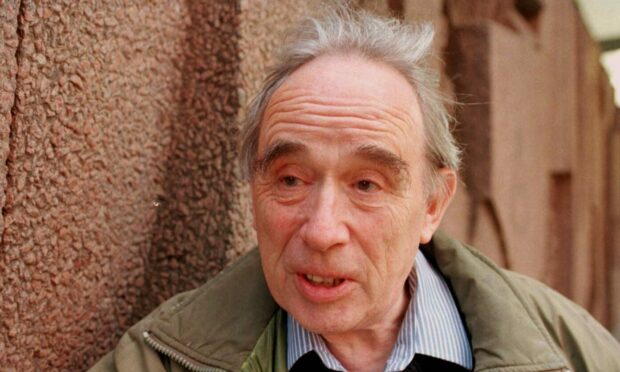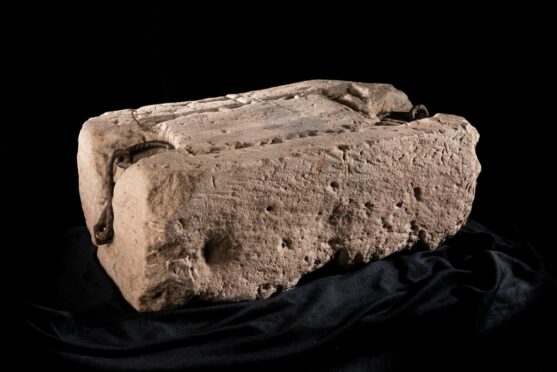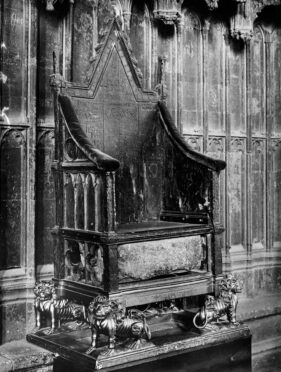Ian Hamilton, an independence activist famous for his daring retrieval of the Stone of Destiny in 1950, has died at the age of 97.
The former lawyer was one of four Scots who broke into Westminster Abbey just before Christmas Day in 1950.
The stone, used to crown the kings and queens of Scotland for centuries, was then smuggled back to Scotland sparking a nationwide hunt lasting months.
The group ended up handing over the stone to the Church of Scotland in April 1951 – a move hailed at the time as a triumph of Scottish nationalism.
It was since returned to Westminster Abbey, but by then Mr Hamilton’s name was written in the history books.
First Minister Nicola Sturgeon led the tributes to Mr Hamilton, calling him a “legend” of the independence movement.
“He will long be remembered as one of the Christmas 1950 liberators of the Stone of Destiny,” she said.
“During my time as the SNP’s leader I have received occasional words of wisdom, encouragement and support from him, which I will always treasure.
“He is one of the many giants on whose shoulders the modern SNP stands.
“My condolences go to his loved ones.”
‘He lived a good life’
Mr Hamilton went on to complete his studies at Glasgow University and became a defence lawyer and a KC.
He joined the Labour Party before running for the SNP in the 1999 Scottish Parliament election and the 1994 general election.
Between 1994 and 1996 he was rector of Aberdeen University and latterly he lived in North Connel near Oban.
His son Stewart Hamilton paid tribute to his father, saying “he lived a good life” who was “much more than that one act”.
He was due to be a guest of honour at the opening of a new museum in Perth next year which will have the Stone of Destiny as its centrepiece.
What is the Stone of Destiny?
Also known as the Stone of Scone, the 400lb sandstone slab is the ancient coronation seat of the kings of Scotland.
It was taken from Scone in 1296 by King Edward I of England during the Wars of Independence and brought to London.
King Edward III of England had promised to return the stone to Scotland under the 1328 Treaty of Northampton but rioting mobs prevented its removal and it remained in Westminster in a specially-constructed throne.
The stone was moved to Edinburgh Castle in 1996 and a replica of the stone sits in the grounds of Scone Palace as well.
It will be moved temporarily back to Westminster Abbey for the coronation of the new King Charles III.
The daring theft
Mr Hamilton, along with his three accomplices, became a household name after he stole the ancient relic on Christmas Day in 1950 and smuggled it back across the border to Scotland.
The gang was made up of Mr Hamilton, then a 25-year-old law student at Glasgow University, fellow students Alan Stuart and Gavin Vernon, and domestic science teacher Kay Matheson.
Initially the foursome had planned to remove the stone from Westminster Abbey two days before Christmas by locking Mr Hamilton inside the church.
He had planned to unscrew the door locks with tools he had hidden in his clothes and let the rest of the group inside – but he was disturbed by the abbey watchman.
The students returned on Christmas Day and took a crowbar to the side door to unlock it.
When they removed the stone from under King Edward’s chair it split into two – Mr Hamilton took the smaller of the two fragments to the Ford Anglia waiting outside.
A passing police officer even stopped to speak to Mr Hamilton and Ms Matheson in their getaway car, who duped the officer into thinking they were a courting couple.
The theft of the Stone ended up forcing the closure of the border between Scotland and England for the first time in 400 years, with hotels and boarding houses on both sides being checked by authorities.
From Westminster to Arbroath – and back
Mr Hamilton and the rest of the group smuggled the stone back to Scotland where it was repaired by Glasgow stonemason Robert Gray.
It was eventually left on the altar of Arbroath Abbey draped in a Saltire and in April 1951 the group left a letter for journalist Arthur Binnie from the Arbroath Herald exposing the heist.
The stone was then returned to Westminster Abbey and the then home secretary decided it was not in the public interest to prosecute Mr Hamilton and the other three.
Mr Hamilton wrote a book about the Christmas Day raid called ‘The Taking of the Stone of Destiny’ – in 2008 the book was turned into a film starring Charlie Cox as Ian Hamilton.
Tributes pour in
Among the messages of condolences, Perthshire MSP John Swinney, the deputy first minister, said: “Terribly sad to hear of the death of Ian Hamilton KC.
“He had a life of towering achievements.
“His courage and creativity in leading the return of the Stone of Destiny inspired a generation to believe in independence.
🏴 All of us at the SNP are deeply saddened at the death of Ian Hamilton. He will be forever remembered for his role in returning the Stone of Destiny to Scotland and as an inspiration to the independence movement.
❤️ Our condolences go to his loved ones. pic.twitter.com/00Jb36SijY
— The SNP (@theSNP) October 4, 2022
“He shaped the Scotland of today.”
Dean of the Faculty of Advocates Roddy Dunlop KC added: “I am deeply saddened to learn of the passing of Ian Hamilton KC.
“A faculty legend, renowned for his fearless advocacy, effortless bonhomie, ‘liberating’ the Stone of Destiny, and MacCormick 1953.
“Ian was a great friend, and a lovely man – he will be sorely missed.”



